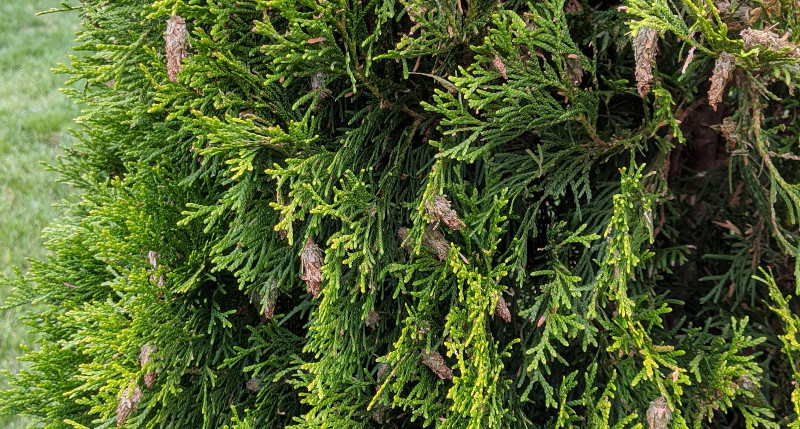Arborvitae are a species of evergreen shrubs and trees that are commonly grown as a privacy screen, wind break, garden border or just to add 4 seasons of interest in the landscape. These bushes are relatively easy to care for. However, one common problem gardeners run into often is bagworms.

What Are Bagworms?
Bagworms are dark brown caterpillars that love to feed on over 128 different plant species. However, arborvitae, red cedar, and juniper are the most common plants that bagworms will eat. The insects are only about an inch long. They weave silk bags (cocoons) as they feed on the branches. The bags are only about 2 inches long, but the infestation can be daunting if not treated right away. The females will actually move the bags with them as they feed on different sections of the plant. The females do not leave the bag. The males are black moths that will fly to the silk bag and mate. Each female can lay up to 1,000 eggs at a time, which can overrun arborvitae in a hurry if not dealt with promptly.

What Do Bagworms Do To Arborvitae?
The damage done by these small caterpillars can be significant and can even kill the plant if left untreated. The insects typically start at the top of the tree and work their way down. Each section is defoliated as the caterpillar feeds and leaves behind brown bare foliage and branches.
Treating Arborvitae For Bagworms
For light infestations, you may be able to just pick the bags off of the tree. Work in sections and try to remove all of them. Each female left behind can produce up to 1,000 eggs, so it is important to not leave any behind. If you cannot reach the top of the tree, you may be able to use a hose to spray the bags off of the tree with a strong spray.

Once you either pick the bags or knock them off, be sure to collect them all and dispose of them. You can either burn the caterpillar and bags or drown them.

If the infestation is too much to treat manually, you can spray bacterium Bacillus thuringiensis (Bt) on the plant. It should be safe for birds and other animals, but will kill the caterpillars once they eat the arborvitae. Treat according to instructions. The best time to treat is in the morning or evening when the worms are feeding. June is usually the best month to use a spray pesticide. If all of your arborvitae are not infected, it is still a good idea to treat them all at the same time.
You can also contact your local extension office for area specific advice on which organic or inorganic options work the best in your area. And also which pesticides are the most effective on bagworms as well as safe for the environment.
Will The Arborvitae Recover From Bagworm Damage?
Unfortunately, it can take a while for arborvitae to recover from bagworm damage. The brown spots may recover or may not. A good way to tell is if you use a fingernail to look for green tissue inside the branches. If there is some green, the branch may still be viable and add new growth the following year. If the branch is dead, it is usually best to just cut the branch off. Even if that means cutting out big portions of the arborvitae. When the plant does recover, it happens from growth on the tips of the branches, which will eventually cover up the damage further inside of the plant. Sometimes, this can take several years if the damage was bad enough. You may decide to just replace the plant if the damage is bad enough or makes the plant look uneven in appearance.
